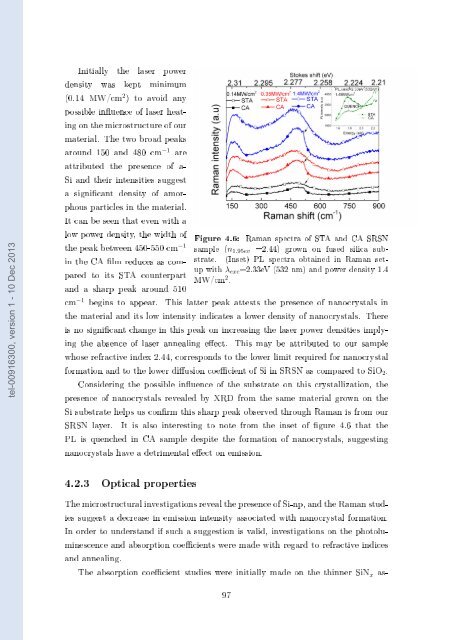Films minces à base de Si nanostructuré pour des cellules ...
Films minces à base de Si nanostructuré pour des cellules ...
Films minces à base de Si nanostructuré pour des cellules ...
You also want an ePaper? Increase the reach of your titles
YUMPU automatically turns print PDFs into web optimized ePapers that Google loves.
tel-00916300, version 1 - 10 Dec 2013<br />
Initially the laser power<br />
<strong>de</strong>nsity was kept minimum<br />
(0.14 MW/cm 2 ) to avoid any<br />
possible inuence of laser heating<br />
on the microstructure of our<br />
material. The two broad peaks<br />
around 150 and 480 cm −1 are<br />
attributed the presence of a-<br />
<strong>Si</strong> and their intensities suggest<br />
a signicant <strong>de</strong>nsity of amorphous<br />
particles in the material.<br />
It can be seen that even with a<br />
low power <strong>de</strong>nsity, the width of<br />
the peak between 450-550 cm −1<br />
in the CA lm reduces as compared<br />
to its STA counterpart<br />
and a sharp peak around 510<br />
Figure 4.6: Raman spectra of STA and CA SRSN<br />
sample (n 1.95ev =2.44) grown on fused silica substrate.<br />
(Inset) PL spectra obtained in Raman setup<br />
with λ exc =2.33eV (532 nm) and power <strong>de</strong>nsity 1.4<br />
MW/cm 2 .<br />
cm −1 begins to appear. This latter peak attests the presence of nanocrystals in<br />
the material and its low intensity indicates a lower <strong>de</strong>nsity of nanocrystals. There<br />
is no signicant change in this peak on increasing the laser power <strong>de</strong>nsities implying<br />
the absence of laser annealing eect. This may be attributed to our sample<br />
whose refractive in<strong>de</strong>x 2.44, corresponds to the lower limit required for nanocrystal<br />
formation and to the lower diusion coecient of <strong>Si</strong> in SRSN as compared to <strong>Si</strong>O 2 .<br />
Consi<strong>de</strong>ring the possible inuence of the substrate on this crystallization, the<br />
presence of nanocrystals revealed by XRD from the same material grown on the<br />
<strong>Si</strong> substrate helps us conrm this sharp peak observed through Raman is from our<br />
SRSN layer. It is also interesting to note from the inset of gure 4.6 that the<br />
PL is quenched in CA sample <strong>de</strong>spite the formation of nanocrystals, suggesting<br />
nanocrystals have a <strong>de</strong>trimental eect on emission.<br />
4.2.3 Optical properties<br />
The microstructural investigations reveal the presence of <strong>Si</strong>-np, and the Raman studies<br />
suggest a <strong>de</strong>crease in emission intensity associated with nanocrystal formation.<br />
In or<strong>de</strong>r to un<strong>de</strong>rstand if such a suggestion is valid, investigations on the photoluminescence<br />
and absorption coecients were ma<strong>de</strong> with regard to refractive indices<br />
and annealing.<br />
The absorption coecient studies were initially ma<strong>de</strong> on the thinner <strong>Si</strong>N x as-<br />
97
















